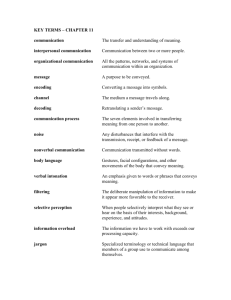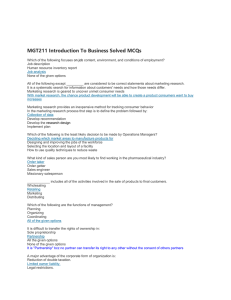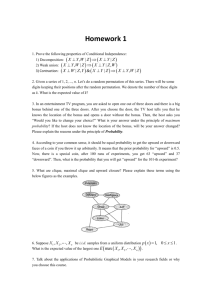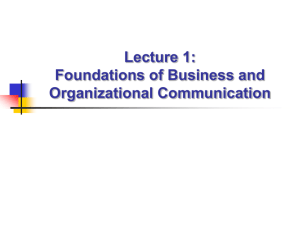Chapter 4 Answers to Problems 1. 5.
advertisement
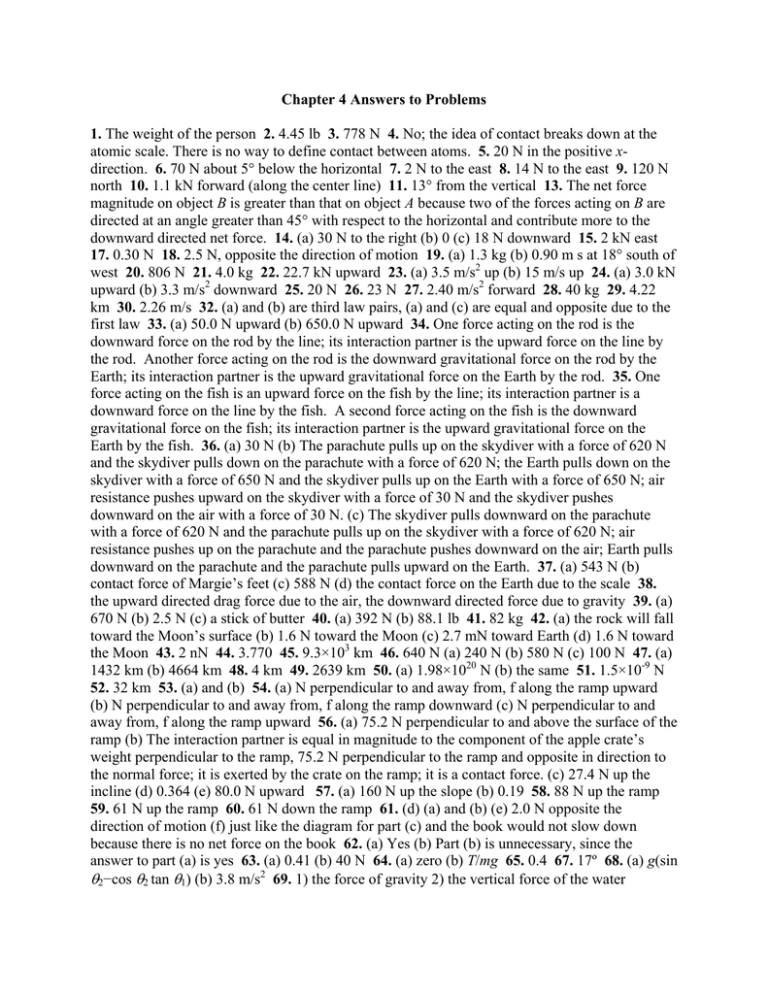
Chapter 4 Answers to Problems 1. The weight of the person 2. 4.45 lb 3. 778 N 4. No; the idea of contact breaks down at the atomic scale. There is no way to define contact between atoms. 5. 20 N in the positive xdirection. 6. 70 N about 5° below the horizontal 7. 2 N to the east 8. 14 N to the east 9. 120 N north 10. 1.1 kN forward (along the center line) 11. 13° from the vertical 13. The net force magnitude on object B is greater than that on object A because two of the forces acting on B are directed at an angle greater than 45° with respect to the horizontal and contribute more to the downward directed net force. 14. (a) 30 N to the right (b) 0 (c) 18 N downward 15. 2 kN east 17. 0.30 N 18. 2.5 N, opposite the direction of motion 19. (a) 1.3 kg (b) 0.90 m s at 18° south of west 20. 806 N 21. 4.0 kg 22. 22.7 kN upward 23. (a) 3.5 m/s2 up (b) 15 m/s up 24. (a) 3.0 kN upward (b) 3.3 m/s2 downward 25. 20 N 26. 23 N 27. 2.40 m/s2 forward 28. 40 kg 29. 4.22 km 30. 2.26 m/s 32. (a) and (b) are third law pairs, (a) and (c) are equal and opposite due to the first law 33. (a) 50.0 N upward (b) 650.0 N upward 34. One force acting on the rod is the downward force on the rod by the line; its interaction partner is the upward force on the line by the rod. Another force acting on the rod is the downward gravitational force on the rod by the Earth; its interaction partner is the upward gravitational force on the Earth by the rod. 35. One force acting on the fish is an upward force on the fish by the line; its interaction partner is a downward force on the line by the fish. A second force acting on the fish is the downward gravitational force on the fish; its interaction partner is the upward gravitational force on the Earth by the fish. 36. (a) 30 N (b) The parachute pulls up on the skydiver with a force of 620 N and the skydiver pulls down on the parachute with a force of 620 N; the Earth pulls down on the skydiver with a force of 650 N and the skydiver pulls up on the Earth with a force of 650 N; air resistance pushes upward on the skydiver with a force of 30 N and the skydiver pushes downward on the air with a force of 30 N. (c) The skydiver pulls downward on the parachute with a force of 620 N and the parachute pulls up on the skydiver with a force of 620 N; air resistance pushes up on the parachute and the parachute pushes downward on the air; Earth pulls downward on the parachute and the parachute pulls upward on the Earth. 37. (a) 543 N (b) contact force of Margie’s feet (c) 588 N (d) the contact force on the Earth due to the scale 38. the upward directed drag force due to the air, the downward directed force due to gravity 39. (a) 670 N (b) 2.5 N (c) a stick of butter 40. (a) 392 N (b) 88.1 lb 41. 82 kg 42. (a) the rock will fall toward the Moon’s surface (b) 1.6 N toward the Moon (c) 2.7 mN toward Earth (d) 1.6 N toward the Moon 43. 2 nN 44. 3.770 45. 9.3×103 km 46. 640 N (a) 240 N (b) 580 N (c) 100 N 47. (a) 1432 km (b) 4664 km 48. 4 km 49. 2639 km 50. (a) 1.98×1020 N (b) the same 51. 1.5×10-9 N 52. 32 km 53. (a) and (b) 54. (a) N perpendicular to and away from, f along the ramp upward (b) N perpendicular to and away from, f along the ramp downward (c) N perpendicular to and away from, f along the ramp upward 56. (a) 75.2 N perpendicular to and above the surface of the ramp (b) The interaction partner is equal in magnitude to the component of the apple crate’s weight perpendicular to the ramp, 75.2 N perpendicular to the ramp and opposite in direction to the normal force; it is exerted by the crate on the ramp; it is a contact force. (c) 27.4 N up the incline (d) 0.364 (e) 80.0 N upward 57. (a) 160 N up the slope (b) 0.19 58. 88 N up the ramp 59. 61 N up the ramp 60. 61 N down the ramp 61. (d) (a) and (b) (e) 2.0 N opposite the direction of motion (f) just like the diagram for part (c) and the book would not slow down because there is no net force on the book 62. (a) Yes (b) Part (b) is unnecessary, since the answer to part (a) is yes 63. (a) 0.41 (b) 40 N 64. (a) zero (b) T/mg 65. 0.4 67. 17º 68. (a) g(sin 2−cos2 tan1) (b) 3.8 m/s2 69. 1) the force of gravity 2) the vertical force of the water opposing gravity 3) the force of the wind 4) the force of the line tied to the mooring 70. 850 N, due west 71. 1.38 kN 72. 400 N 73. Lower cord 8.3 N, Upper cord 12.4 N 74. both scales read 120 N 75. scale A reads 120 N, Scale B reads 240 N 76. Scale B reads 120 N, Scale A also reads 120 N 77. (a) √(2) Mg (b) 45º 78. (a) 34 N (b) 39 N 79. 30 N, 18 N 80. W/(2sin 81. 2.0 N toward the back of the mouth 82. 98 N 83. m1/(m1+m2) 84. 0.50 m 85. (a) 20 N (b) 12 N 86. 3.5 N 87. (a) 3.9 m/s2 to the right, 3.9 m/s2 downward (b) 4.7 m/s to the right (c) 2.8 m (d) 0.31 m to the right, 0.31 m down 88. 1.0×105 N in the direction of motion 89. (a) a1 = 2.5 m/s2 up and a2 = 2.5 m/s2 down 90. 1.8 m/s2, yes 91. 0.81 s 92. (a) 0.34 m/s2 , where the watermelon moves up and to the left (b) 1.5 cm (c) 6.8 cm/s 93. 0.365º 94. (a) 80 N directed down the incline (b) 8.0 m/s2 directed down the incline (c) 1.2 s 95. (a) μs > 0.48 (b) 0.60 (c) 0.48 96. 3.2 kN, 1.1 kN 97. 642 N 98. 0.8 m/s2 downward 99. 1 kN upward 100. (a) 567 N (b) 629 N 101. (a) 1.4 m/s2 downward (b) no 102. 766 N downward 103. 620 N 104. (a) 2.2 m/s2 up (b) 784 N 105. the weak force 106. gravitational force 107. electromagnetic and gravitational forces 108. electromagnetism 109. the strong force 111. (a) 23 m/s (b) 0.19 112. 440 N 113. (a) zero (b) 2.6×104 N 114. (a) 44 N (b) 38 N (c) 38 N 117. (b) 860 N 118. (a) in each case, the two ropes pull on the scale with forces of 550 N in opposite directions, so the scales give the same reading (b) 550 N 119. 0.027 N/kg 120. 0.49% 121. (a) 80 N (b) 160 N 122. mg/cos 123. (a) 1360 N (b) 21.5º 124. (a) 16 N (b) the block will accelerate (c) 1.3 m/s2 125. F/3 to the right 126. 2.0×105 N west 127. (a) 22º with respect to the horizontal (b) 0.9 m/s2 down the incline 128. (a) 1.8 m/s2 down (b) 8.7 m/s 129. (a) No (b) yes (c) 0.6 m/s2 (d) the force of friction will be less on the Moon, more 130. the arrangement in Fig. (a) breaks the twine, the arrangement in Fig. (b) successfully hangs the picture 131. 120 N 132. (a) 250 N (b) 3100 N (c) 250 N toward the satellite 133. 90.0% of the Earth-Moon distance 134. (a) 55 m (b) 7.5 s 135. (a) 1.5 N upward (b) 2.4 N upward (c) 0.85 N downward (d) 0.85 N downward, 9.80 m/s2 downward 136. (a) all 0 (b) A > B > C (c) 16.5 N, 11.0 N, 5.5 N 137. (a) 110.0 N (b) 115.0 N, 110.0 N 138. (b) zero (c) 52 N 139. (a) 1) The gravitational forces between the magnet and the Earth 2) The contact forces, normal and frictional, between the magnet and the photo 3) The magnetic forces between the magnet and the refrigerator (c) The long-range forces are gravity and magnetism. The contact forces are friction and the normal force (d) Wme = 0.14 N, Fmr = 2.10 N, fmp = Wme = 0.14 N, and Nmp = Fmr = 2.10 N 140. 610 N 141. (a) 137 N, 39 N (b) 147 N, 39 N 142. (a) zero (b) 18 N in the forward direction (c) 2.9 m/s2 143. (a) mg tan (b) mg tan(c) mg tan+ ma/cos 144. (a) (m1+m2)g (b) (m1+m2)g(cos+sin) 145. (a) 1.10mg (b) 1.10mg 146. (a) 15 N (b) 8.8 N 147. 1810 N, 5 times the force with which Yoojin pulls, the oak tree supplies additional force 148. (a) 98 N (b) 60° above the horizontal 149. (a) 2.60×108 m from Earth (b) away from 150. (a) toward the wall (b) away from the wall (c) 0.1, If the frictional force on the picture exerted by the hand is less than the force exerted on the picture due to gravity, the frictional force on the picture due to the wall is directed upward so that the net vertical force is zero. If the frictional force exerted by the hand is greater than that due to gravity, the force due to the wall is directed downward for the same reason. 151. 15 m/s2 152. (a) 5.0º from the vertical (b) 0.52 m/s2, 0.02 m/s2 153. (a) a = (m2-km1)g/(m1+m2), T = (1+k)m1m2g/(m1+m2) (b) g, (1+k)m1g<<m2g so the tension is negligible compared to the weight of m2; it’s essentially in free fall. m2g, (1-k)g/2, (1+k)mg/2 (c) a = 0 only for m2 = 0; thus, there is no value at which the two masses slide with constant velocity. For m2=0, there is no tension in the cord.
